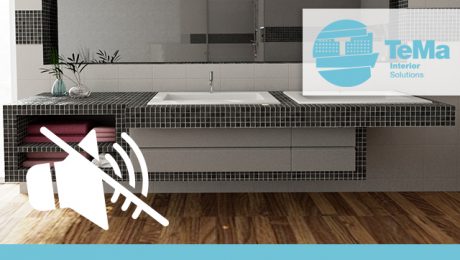Soundproofing the bathroom: Why not?
Having a shower in the middle of the night or at the crack of dawn, flushing the toilet, walking heavily barefoot, dropping bottles, a washing machine spinning, water draining or a jacuzzi in operation. All such activities often take place at times when your neighbours may not want to hear you.
Nothing illegal, but it’s most likely to be very annoying for any neighbours who are sleeping.
Don’t be surprised, there’s a solution to this too: install noise-reducing products in the bathroom.
Where does noise come from?
We are used to thinking that noise is transmitted through the air, but sometimes we forget that walls and pipes also transmit vibrations.
In blocks of flats this is even more amplified, as flats are generally designed in a similar way and systems run in sections between floors: this carries much more noise and rumblings.
Our solution
First and foremost, the ideal solution is to carry out a sound test in order to find out what noise is in that room and design a customised soundproofing system.
Environmental comfort can be taken care of by T-Silence dB21, the panel comprising an internal polymer core bonded with special fabrics on both sides, which reduces noise by 21 dB in a thickness of just 7.5 mm.
T-Silence dB21 is particularly suitable for renovations, as it can be dry-installed without having to a make a new screed (thus saving time, since long drying periods are not required). Furthermore, if not irreparably uneven, the old floor need not be demolished, as T-Silence can be installed over it. It can then be directly cladded with ceramic tile or wooden flooring, or a floating floor system can be installed. If, instead, you decide to remove the existing floor because it’s uneven and then lay T-Silence over the screed, as it is reduced in thickness, it isn’t necessary to intervene on the thresholds between one room and another, as no difference in level will occur.
Beware of acoustic bridges
An acoustic bridge is a critical issue that risks undermining all insulation work. It basically transmits noise and vibration. To prevent this, the joints between T-Silence dB21 panels need to be covered with dB-Strip, the paper adhesive tape impregnated with hot melt adhesive, and dB-Band, the self-adhesive band for perimeter insulation in contact with vertical walls.
Advantages
Insulating the bathroom brings the advantage of enhancing rest and therefore personal well-being.
Moreover, as it is relatively uncommon, it adds value to your property.
- Published in news


